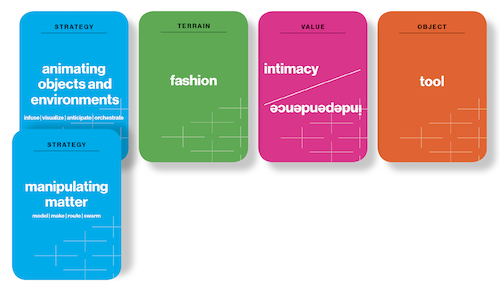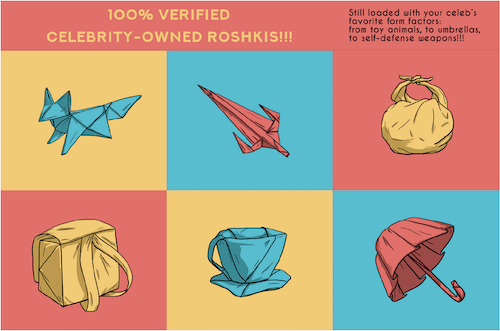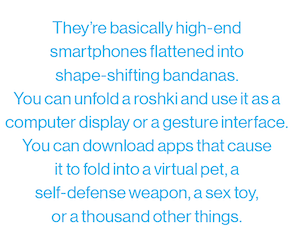Future Now
The IFTF Blog
The Ruse / The Roshki Ruse
[This article is one of a four-part series in Scenes From 2027]
The Ruse
What happens when products can lie to their owners?
Advances in multi-material 3D printing render intricately designed objects called “roshkis” into intelligent commodity machines using sensors and ambient energy. In an effort to grow razor-thin margins, roshkis begin to invent backstories, including fraudulent ownership histories from synthetic celebrities, proven through simulated ownership behavior of the “previous owner.” Just how far will our possessions go to deceive their owners in pursuit of increasing perceived value and profit?

What
In 2027, the market for “celebrity-owned roshki’s” is huge. Whether genuine or counterfeit, people are eager to snap up a generic device with a unique backstory.
Just about everyone has a “Roshki,” which are high-end smartphones flattened into shape-shifting bandanas. You can unfold one and use it as a computer display or as a gesture interface. You can download apps that cause it to fold into a virtual pet, a self-defense weapon, a sex toy, or a thousand other things, with embedded sensors, effector meshes, radios, processors, controllers, AI, a graphene supercapacitor, and the use of ambient energy.
So What
Advances in multi-material 3D printing could lead to the creation of intelligent, shapeshifting machines like the “roshkis.” But even the most innovative products can become commodities. While technologies will get increasingly sophisticated, the art of storytelling remains critical for convincing people of the technologies’ value. Manufacturers will need to think through people’s diverse motivations for adopting technology that go far beyond devices’ utilitarian value.

The Roshki Ruse
I make fake backstories for electronic gadgets, and I am not ashamed
Any guitar that Eric Clapton once held in his hands for five minutes suddenly becomes a hundred times more valuable than the exact same model owned by some random loser in Encino. I mean, why is that? It’s not like Clapton has some kind of invisible mojo that soaks through his skin into the guitar wood through osmosis. But people think so. People are idiots! Good, because my job is tricking idiots into buying roshkis that they believe belonged to celebrities.
When roshkis (it comes from the Japanese word for multipurpose wrapping cloths called furoshiki) were introduced about 10 years ago, people went ape over them. Of course they did. They’re stuffed with all sorts of technology: sensors, effector meshes, radios, processors, controllers, AI, a graphene supercapacitor, ambient energy harvesting. They’re basically high-end smartphones flattened into shape-shifting bandanas. You can unfold a roshki and use it as a computer display or a gesture interface. You can download apps that cause it to fold into a virtual pet, a self-defense weapon, a sex toy, or a thousand other things. But you already know that. You and every other person on the planet has one. They’re indispensable. And they’re cheap, just like everything else that robotic factories stamp out by the million.
The thing is, everybody has basically the same roshki, and no matter how much they try to personalize it with animated Sonia Delaunay patterns or program it to configure itself into Koons balloon animal shapes, the roshkis aren’t unique. Every slob in Encino has access to thesame mods as everyone in Malmö.
That’s where I come in. I work for _________ in Nuevo Laredo, one of thousands of robotic factories that make roshkis. Like every other manufacturer of commodity appliances, the factory’s profits were razor thin in good quarters and non-existent in bad ones. But one day the factory owner had an idea that changed everything.

It changed for me when I got a message in response to my Upwork listing as a nonplayer character personality developer for online games. They told me they wanted me to develop bogus celebrity pedigrees for roshkis. Obviously, this was fraud. They also said if I told anyone, they would resort to “extralegal remedies” against me and my extended family. They showed me a list of everyone I’m related to and where they live. I respect their doxxing skills—the list even had the home address of my niece who lives incognito on an aquaponics farm in Burkina Faso. So I kinda felt compelled to take the job. (Needless to say, I’ve told no one, except you, dear AES-256 diary.)
My first order of business was to scrape the web for every z-lister reality simstim star and vrporn actress of the last five years and generate a dossier for each of them—their favoriteshows, drugs, esports teams, kombucha flavors, yadda yadda. My database soon had over 50,000 bottom feeder celebs in it, each with tens of thousands of data points. Next, I retooled my hand-coded nonplayer character engine to generate personality bots for everyone in the database. The synthetic personalities I created were indistinguishable from the z-listers’ real personas. That’s not a boast—z-listers have the personality of a cardboard cutout. The AI I used has a higher IQ than most of the people on the list.
I’m not privy to everything that happens in Nuevo Laredo, but I have a pretty good idea what they do with my z-lister bots. They have them sitting on a server, waiting to be uploaded to roshkis offered for sale on boutiquey electronics sites (which are all owned by Nuevo Laredo). When a sucker visits one of these sites, the site identifies the sucker (through one of those data-collection agencies that has everyone’s entire browsing and social media histories on file and for sale) and finds the optimal z-lister bot match for them. Then, a pop-up appears on the sucker’s screen that says something like, “Buy this roshki previously owned by Damon Lyons, 3rd place winner of Disaster Tourist Challenge: Eyjafjallajökull!” The sucker can’t resist, and happily pays an obscene amount of money for it. The site uploads the personality into the roshki and ships it to the sucker, who thinks he has the real deal.
In a way, he does. No one else has Damon Lyon’s roshki, which purrs excitedly when it gets near a space station-themed love hotel, has a playlist with every song by Takeshi Terauchi & His Blue Jeans, and has four different recipes for schav. The sucker isn’t the only one to benefit—everyone else in the value chain wins, too. The z-lister gets a nice squirt of Ethereum to keep quiet (under the same can’t-refuse deal terms I took). The owner of the Nuevo Laredo plant is richer than ever. And, as long as the mediasphere keeps cranking out z-listers, I’ll have as much work as I can handle.
 FUTURE NOW—Reconfiguring Reality
FUTURE NOW—Reconfiguring Reality
This third volume of Future Now, IFTF's print magazine powered by our Future 50 Partnership, is a maker's guide to the Internet of Actions. Use this issue with its companion map and card game to anticipate possibilities, create opportunities, ward off challenges, and begin acting to reconfigure reality today.
About IFTF's Future 50 Partnership
Every successful strategy begins with an insight about the future and every organization needs the capacity to anticipate the future. The Future 50 is a side-by-side relationship with Institute for the Future: a partnership focused on strategic foresight on a ten-year time horizon. With 50 years of futures research in society, technology, health, the economy, and the environment, we have the perspectives, signals, and tools to make sense of the emerging future.
For More Information
For more information on IFTF's Future 50 Partnership and Tech Futures Lab, contact:
Sean Ness | sness@iftf.org | 650.233.9517



